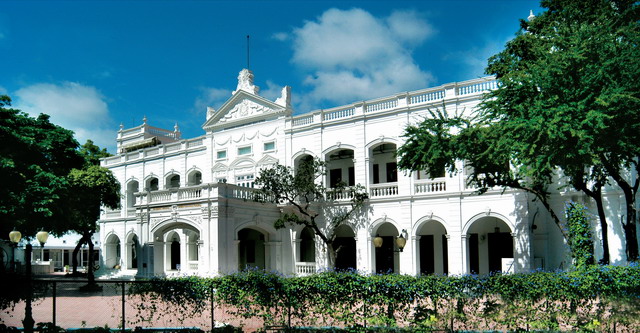 Home > Mission Activities | |
|
The Mission The Gurus Dada's Teachings Mission Activities Publications Worldwide Centers Picture Galleries Panama Center Center Activities Center Events Nuri Granth Anjali Sangraha Selected Lyrics  Selected Audio   Videos  |
 Activities Of Sadhu Vaswani Mission
EducationIn 1933, Sadhu Vaswani founded the "Mira Movement In Education" which has, today, its headquarters at Pune. The Movement was started in Sind and plans were afoot to develop it into a Mira University, when the "partition" came to paralyse the best efforts of enlightened men in Sind. The Mira Movement attempts at enriching students with vital truths of modern life and at the same time making them lovers of the Indian Ideal and India's Culture, at once idealistic and spiritual. Such an education is essential to India's social and political salvation. The emphasis in the teaching passed on in Mira Educational Institutions is that education is a thing of the Spirit and that the end of all knowledge is service, - service of the poor and lowly, the sick and afflicted ones. In 1962, Sadhu Vaswani started St. Mira's College for Girls. It is inspired by the faith that, in the new unfolding of India's destiny, women have to play an important part. As Sahdu Vaswani often said:- "The woman-soul will lead us upward, on!" And while students in the College are trained to show good results at the University Examinations, the emphasis in the teaching passed on them is on three things:- (1) character building; (2) heroic living; and spiritual unfolding. The Mira Movement in Education has grown and expanded to run no less than six educational institutions in Pune - all of them reputed for their strong sense of discipline, and their insistence on character building, love of Indian ideals, reverence for all life, spiritual, cultural, social and moral values. Over 5,000 students receive their education from these institutions, starting from the pre-primary level and going right up to post-graduate classes. Schools have also been established at Delhi, Baroda, Ahmedabad, Rajkot and Bombay.
Some of the different methods employed in the educational institutes are: HealthcareIn Pune, medical services are offered by the Mission at the following centers:- Shanti Clinic: a diagnostic center located on the Mission campusThe Mangharam Khemlani Dispensary The Sadhu Hiranand Free Homeopathic Dispensary The Radha Krishna Daya Dispensary The Inlaks and Budhrani Hospital: a 150 bed hospital in Koregaon Park The Cancer Institute: a 175 bed hospital specially for cancer patients The motto of all the Medical Centers of the Mission is:
Every patient is a picture of God. Freeships and concessions including expensive medications and injections are liberally given to poor and needy patients. Village UpliftmentThe Mission has undertaken the work of village upliftment in the backward areas of Maharashtra, Saurashtra and Kutch. Its village adoption programmes help provide employment and improve the quality of life for villagers living below the poverty line. The activities of the programme include the provision of drinking water, digging of irrigation wells, tree plantation, soil conservation, education of children, training households to work and earn their own living, health camps, vocational training classes, service to mother cows at times of famine, and rehabilitation of poor families, provisions of rations etc.Animal Welfare"For me not to love birds and animals would be not to love the Lord", Sadhu Vaswani said. The Mission follows his precept that all life is sacred, and that birds and animals are our brothers and sisters in the One family of creation. These humble creatures are fed twice a day at the Sadhu Vaswani Ashram. Students of the St. Mira's Educational institutions bring handfuls of grain, slices of bread, chappatti etc. to feed birds and animals with their own hands. SatsangSatsangs are held thrice everyday including kirtans, bhajans, and recitations from holy scriptures, Sadhu Vaswani's recorded upadeshes and Dada's upadeshes inspire and thrill hundreds of brothers and sisters. Days sacred to the great ones of East and West are also celebrated with prayers and service. The satsang forms the basis of the Sadhu Vaswani Mission. "The noblest work", according to Sadhu Vaswani, "is to cultivate the soul! ".Dada BhandaraAt the Dada Bhandara the poor are fed meals everyday with reverence and love, and are asked to sing the holy name of God. Food and snacks are sent out to other institutions for the blind, the handicapped, the aged, the orphans, the mental patients and the lepers practically everyday. Daily fruits and biscuits are distributed at the poor patients wards for children and adults at the general Sassoon Hospital in Pune.Promotion Of Sindhi LanguageThe Sadhu Vaswani Mission has devoted special efforts to run classes in the Sindhi language. Crash courses in Sindhi are regularly conducted for aspiring learners, and have proved very popular with the younger generation. An increasing number of students have learnt to read and write Sindhi in the original Arabic script, or even in Devnagiri, as an easier alternative. To many earnest Sindhi lovers, these classes have opened the door to the vast literary treasures which exist in the Sindhi language.
|